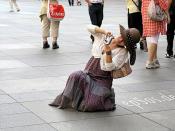The chapter out of Susan Sontag's book "On Photography" writes on interesting points of photographic images in our society. She writes, "Humankind lingers unregenerately in Plato's Cave, still reveling, its age-old habit, in mere images of the truth." (p. 3) With these words she is stating the importance and the effects that photographs have on the images in our world. The truths in which they reveal are remnants of what we perceive as truth.
She mentions how photographs give certain images worth and that worth is placed according to the photograph. This is true in many aspects. Would national monuments be as important if they were not photographed as often? No, the fact is our ideas of worth are based solely on what we know of them through pictures and drawings. For example, there is a valley in the Sierra Nevada that was carved millions of years ago by a glacier.
This valley is world renowned for its beauty and is one of the most photographed sites in the world, Yosemite National Forest. Most people have heard and might have visited Yosemite but rarely do you hear of the valley south of Yosemite, which was formed in the same way, Muir Valley. Just as glorious to the eye as Yosemite, Muir Valley goes virtually unmentioned. You won't see professional photographs or special books and videos of this Valley because it is deep within the roughed terrain of the Sierra Nevada and its only entrance is a long strenuous hike on foot. Sontag would say that because Yosemite is photographed millions of times each year that it's worth it proven over and over again. It is not the awesomeness alone that makes a natural wonder a true wonder but it's accessibility to duplications of it through photographs.
One of the...


